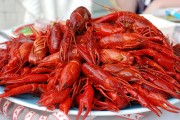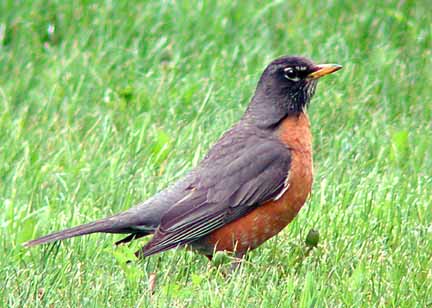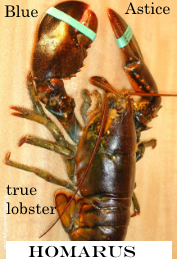“Crayfish” also known as “lobster”, “langoustine”, “scampi” . . . (you get the picture)
It appears over the centuries, the terms for shellfish such as lobster, the Norway lobster, scampi, crayfish, prawn, and even shrimp were used interchangeably in different countries and in different languages. It's of little wonder that today, the term lobster is given ubiquitously to cover a wide range of crustaceans, both freshwater and marine.
From an academic paper titled Crayfish terminology in ancient Greek, Latin, and other European languages
From Aristotle to modern astacologists, different terms have been used in different European countries to express the notion “crayfish”. In Ancient Greek, “κάραβoς” (káravos) was used for spiny lobster, while άστακός (astakós) for both lobster and freshwater crayfish. The word “άστακός” was used by Greeks for naming towns and persons and as a city symbol on coins.
Further on
In the Renaissance, the freshwater crayfish was “cambarus” in popular Latin, and “astacus” in scientific Latin. Modern words such as in Italian (gambero), Castilian (cangrejo), Catalonian (cranc), and Old French of southern France (chambre and cambre) seem to be descendants of the popular Latin term (cambarus). One might detect similarities in the sound of the words for freshwater crayfish across European countries: the German (Krebs), French (écrevisse), or English (crayfish), and these appear to have affinities with the terms in Old Dutch, Old English, Luxemburgian, Dutch, Danish, Swedish, and Norwegian.
[. . .]
The Greek philosopher Aristotle (384-322 B.C.) provides the earliest extant literary reference to crayfish “άστακός” in his Historiae Animalium (HA line 530a 28). According to Cuvier (1803) and Huxley (1880a: 13; 1880b: 8-9), Aristotle used the term “άστακός” mostly for the European lobster, Homarus gammarus (Linnaeus, 1758). [...] He attempted to make a distinction between “άστακός” [i.e. the Italian astice] and another similar aquatic animal, the “κάραβoς” [aragosta]. According to him, these two animals could be distinguished mainly by the presence or absence of large claws. So he called “κάραβoς” those animals without claws and “άστακός” those with claws.[...]. Elsewhere in HA, Aristotle mentioned that the smaller of the two animals, “άστακός”, lived in rivers (HA, line 528 a 28). The authors believe that in this case “άστακός in rivers” was the freshwater crayfish
To confuse the aquas (a literal translation of an Italian idiom) even further, modern Greek has reversed the meanings of these two terms: today atakόs is the marine European spiny lobster (Pallinurus elephas) which has no claws, while Καραβίδα (karavίda) is the freshwater crayfish (Astacus astacus) and the Norway lobster (Nephrops norvegicus), both of which have claws.

Coin from the city of Priapos, Mysia, (today Karabiga; Turkey) 1st century B. C. displaying the head of Apollo on one side and [possibly] of a crayfish on the other.
The term crayfish is said to be derived from Old High German krebiz, meaning "edible crustacean" this became crevice in Old French, which in turn became crevise in English. Eventually, people began pronouncing the ending vise as fish. In 1555 the first spelling of crayfish is recorded, and due to a variation in Anglo-Norman pronunciation, two spelling forms exist in English today: crayfish and crawfish.
Lobster a “poor man's food”
Apparently, the first pilgrims to New America did not consider lobster (but which species or variety of shellfish is not specified) to be a delicacy.
“Lobster, much as today, was considered especially elegant and appropriate food for lovers, being an aphrodisiac. There is a common perception that lobster was considered a poor man's food, and this may have been in the case in colonial New England but not back in Europe. In fact English man-about-town Samuel Pepys's diary records than an elegant dinner he threw in 1663 included a fricassee of rabbit and chickens, carp, lamb, pigeons, various pies and four lobsters...”
Food in Early Modern Europe, Ken Albala [Greenwood Press:Westport CT] 2003 (p. 75)
A similar citation exists which confirms the once held belief that lobster was a humble dish
“The American lobster (Homarus americanus) is today one of the more expensive food items on the market, owing to the difficulty of obtaining sufficient quantities to meet the demand. But when the first Europeans came to America, the lobster was one of the most commonly found crustaceans. They sometimes washed up on the beaches of Plymouth, Massachusetts, in piles of two feet high. These settlers approached the creatures with less than gustatory enthusiasm, but the abundance of lobsters made them fit for the tables of the poor... In 1622 Governor William Bradford of the Plymouth Plantation apologized to a new arrival of settlers that the only dish he "could presente their friends with was a lobster... without bread or anyhting els but a cupp of fair water."
Encyclopedia of American Food and Drink, John F. Mariani [Lebhar-Freidman:New York] 1999 (p. 186)
However, this citation, appealing though it may be, appears to only contain a half-truth. According to Sandy Oliver, author of several books of food history, John Mariani's encyclopaedia is a weak source:
It is true that Bradford said that about lobsters, and that must be put into the context of a proper, formal 17th century meal containing animal meat, not merely seafood alone. Bradford is saying they had no beef or pork or mutton which, in the days when a gentry meal had on the table several dishes some of which included one or more of those served in a rather whole condition, in a joint, plus bread, and wine or other brewed beverage. It is not a slam against lobster—merely a statement of fact.
What Is True About Lobster?
This clarificatory statement ties in with Samuel Pepy's diary entry which I cited earlier.
Is this really ‘lobster’?
Some answers have suggested in order to avoid receiving the clawed lobster species, the term spiny lobster should be used in a restaurant. But even that term is fraught with ambiguity and (apparently) there's no guarantee that the customer will receive the Palinurus elephas species.
The American Heritage® Dictionary of the English Language, states:
spiny lobster Any of various edible marine decapod crustaceans of the family Palinuridae, having a spiny carapace and long antennae and lacking claws. Also called crayfish, langouste, rock lobster, sea crayfish.
The heated diatribe on the ‘correct’ nomenclature is not old. The website Deep Sea News has an article dated 2011, Are crawfish really lobster? The author Miriam Goldstein sustains that crawfish are in fact more closely related to clawed lobsters (H. americanus) than to California spiny lobsters.

The article mentions the gourmet grocery store Zabar’s in New York City which sold “lobster salad” at $16.95 per pound to its customers
But for the last 15 years, the lobster salad has been made with freshwater crawfish – it contained no actual lobster at all.
Further on
• Infraorder Astacidea: We’ve now excluded most of the other tasty shrimp- and crab-looking dudes. They get their own infraorders – for example, the true shrimps are in Caridea, the true crabs are in Brachyura, the hermit crabs are in Anomura, etc. But we’ve ALSO broken off the tropical spiny lobsters! They ALSO get a separate infraorder: Palinura! What’s left in Astacidea? Just the clawed lobsters and the crawfish!
• Family Nephropoidea (lobsters) and Family Astacoidea (crawfish)
In other words, crawfish are way closer to clawed American lobster than they are to clawless California or Caribbean spiny lobster! Perhaps Mr. Zabar has a background in marine biology, because it is actually more correct to call crawfish “lobsters” than it is to call all those tropical non-clawed lobsters “lobsters.”
All emphasis in bold type are mine












 no claws :
no claws : 